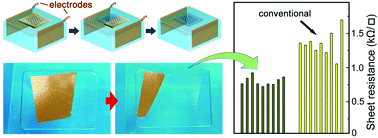High-quality graphene transfer via directional etching of metal substrates†
Abstract
Large-scale applications of graphene require its high-efficiency transfer from growth metal substrates to any other substrates of interest. The wrinkles and folds generated during the transfer process of graphene by the well-known poly(methyl methacrylate) (PMMA)-assisted technique is a critical issue. Here, we report an improvement of this method by applying a directional etching process for the removal of the growth Cu substrates, using a pair of electrodes inserted into the etchant with a constant current to form an electrochemical system. The controlled redox reactions between the Cu and the solution environment result in the etching of Cu in a part-by-part manner strictly from one end to the other. The consistency of the Cu etching direction can avoid the formation of an easily destroyable Cu structure and release the stress concentration that is usually generated during the random etching process, and finally yield significantly improved quality of the transferred graphene film with a lowered density of wrinkles, cracks/folds, adlayers, reduced root-mean-square of surface roughness, and increased performance in sheet resistance and carrier mobility.



 Please wait while we load your content...
Please wait while we load your content...